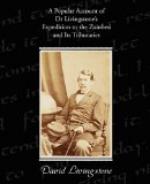CHAPTER I.
Arrival at the Zambesi—Rebel Warfare—Wild Animals—Shupanga—Hippopotamus Hunters—The Makololo—Crocodiles.
The Expedition left England on the 10th of March, 1858, in Her Majesty’s Colonial Steamer “Pearl,” commanded by Captain Duncan; and, after enjoying the generous hospitality of our friends at Cape Town, with the obliging attentions of Sir George Grey, and receiving on board Mr. Francis Skead, R.N., as surveyor, we reached the East Coast in the following May.
Our first object was to explore the Zambesi, its mouths and tributaries, with a view to their being used as highways for commerce and Christianity to pass into the vast interior of Africa. When we came within five or six miles of the land, the yellowish-green tinge of the sea in soundings was suddenly succeeded by muddy water with wrack, as of a river in flood. The two colours did not intermingle, but the line of contact was as sharply defined as when the ocean meets the land. It was observed that under the wrack—consisting of reeds, sticks, and leaves,—and even under floating cuttlefish bones and Portuguese “men-of-war” (Physalia), numbers of small fish screen themselves from the eyes of birds of prey, and from the rays of the torrid sun.
We entered the river Luawe first, because its entrance is so smooth and deep, that the “Pearl,” drawing 9 feet 7 inches, went in without a boat sounding ahead. A small steam launch having been brought out from England in three sections on the deck of the “Pearl” was hoisted out and screwed together at the anchorage, and with her aid the exploration was commenced. She was called the “Ma Robert,” after Mrs. Livingstone, to whom the natives, according to their custom, gave the name Ma (mother) of her eldest son. The harbour is deep, but shut in by mangrove swamps; and though the water a few miles up is fresh, it is only a tidal river; for, after ascending some seventy miles, it was found to end in marshes blocked up with reeds and succulent aquatic plants. As the Luawe had been called “West Luabo,” it was supposed to be a branch of the Zambesi, the main stream of which is called “Luabo,” or “East Luabo.” The “Ma Robert” and “Pearl” then went to what proved to be a real mouth of the river we sought.




